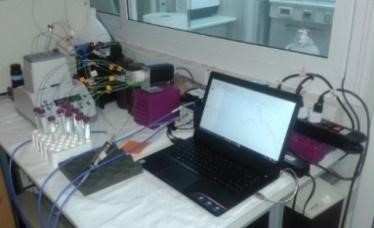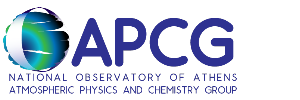Research Project Synopsis
It is well established that increased particulate matter (PM) concentrations are adversely linked to premature mortality, cardiovascular disease, acute respiratory disorders and oxidative stress. It is believed that reactive oxygen species (ROS), generated from photochemical reactions in polluted air and as a response to PM exposure, can induce oxidative stress in exposed populations and ecosystems. ROS activity represents the key mechanistic biological process leading to adverse responses to PM exposure (Ayres et al., 2008), and integrates over all chemical species that possess this property. This fact renders particle ROS activity characterization a powerful tool to identify critical aerosol components, and the respective sources that lead to various health responses. Although the measurement of PM ROS activity is of growing importance, availability of ROS data is mostly limited to a few locations worldwide.
The main goal of the proposed work is to assess the potential health impact of aerosols in two locations in Athens and other five major cities in Greece via the characterization of their ROS activity, using a combination of field and laboratory studies complemented by statistical analysis, and to attribute this activity to specific aerosol sources. The findings will be used to inform the public and policy makers, in order to take measures for the reduction of human exposure to these aerosol sources.

Project Scope
To reach its main goal, REGENERATE will address the following important scientific questions that have been poorly investigated until now:
- I) Which are the atmospheric ROS levels and the oxidative potential (OP) in the greater area of Athens and in other major cities in Greece?
- II) Which are the temporal contrasts of ROS and of the related aerosol constituents in these polluted urban environment?
III) Which aerosol component have the highest toxicity and which sources contribute most to ROS levels seasonally?
- IV) What is the difference between the oxidative potentials of the total aerosol and of water-soluble aerosol fraction?
Research Objectives
To address these questions REGENERATE will pursue the following 3 main objectives:
- • Investigating the spatial and temporal variability of Oxidative Potential of PM. Novel facilities, and state-of-the-art measurement techniques and instrumentation will be used to quantify the amount and stability of ROS (both water soluble and total), at urban and sub-urban locations. This information is critical for understanding the sources and atmospheric transformation processes of the healthrelevant parameters of different aerosol types (WP2).
- • Linking ROS to chemical composition and to various sources of PM. Through targeted chemical analyses that will provide time-series of different aerosol constituents during a complete year at various locations, the contribution of the various sources will be obtained. Sources of pollution will be identified using a widely applied statistical technique named Positive Matrix Factorization (PMF) analysis. It will provide the first ever experimental characterization of the contribution of the various PM sources on ROS activity in Athens and other 5 major Greek cities on an annual basis (WP3).
- • Assessing the toxicity of the various PM sources. By using multivariate statistical analysis between aerosol sources and ROS, the toxicity, expressed by the intrinsic DTT activity, of specific aerosol sources such as traffic, biomass burning (BB) and aged/processed aerosol can be estimated. The calculated toxicity can be then compared with that derived by analyzing aerosol samples collected under the influence of a single source (laboratory samples; WP4).
Instrumentation
For the determination of ROS at all the selected sites, sampling will be performed either by high- or low-volume samplers on quartz fiber filter substrates (4.7 cm and 15 cm diameter PallFlex) for 24-h, and during intensive measurement campaigns, on a 12-h basis. After sampling, filters will be stored in a freezer (-18 oC) until their analysis.
From the developed methods, the DTT assay has been characterized as being able to mimic the electron-transfer mechanism of ROS production in mitochondria, through the transfer of electrons from DTT to oxygen by redox-active species. The reaction rate, expressed by the consumption of DTT over time, is directly proportional to the concentration of the redox-active species in PM extracts. The semi-automated system developed for this kind of measurements (Fang et al., 2015) uses programmable syringe pumps with selector valves, where aerosol extracts oxidize DTT in a single vial. A small volume is withdrawn at several time intervals in order to determine the DTT concentration that remains in the solution, and calculate the consumption rate of DTT.
For the determination of the chemical composition, high-resolution measurements during the intensive measurement campaigns in Athens will be performed using an Aerosol Chemical Speciation Monitor (ACSM) which provides the concentrations of the main atmospheric constituents, namely sulfate, organics, ammonium, nitrate and chloride. ACSM has been already used successfully in a long-term study in Athens (Stavroulas et al., 2019).
Finally, for the determination of the different aerosol sources, over the last few years, several studies have successfully exploited the PMF algorithm, for apportioning the obtained organic mass spectra in terms of source/process-related constituents (Zhang et al., 2011).


Communication/ Outreach
The results of the research have already been communicated to the scientific community via four (3) participations in International Conferences:
1) *G. Kastrinaki, D. Paraskevopoulou, D.G. Kaskaoutis, A. Bougiatioti, N. Hatzianastassiou, N. Mihalopoulos: Witer-time aerosol chemical composition in Northern Greece: Biomass burning effect, European Aerosol Conference 2021, Virtual Conference, August 30- September 3, 2021.
2) *D. Paraskevopoulou, G. Grivas, A. Bougiatioti, M. Tsagkaraki, P. Zarmpas, A. Nenes, N. Mihalopoulos: Long-term measurements of Oxidative Potential in an urban site, Athens, Greece, International Aerosol Conference, 4-9 September 2022, Athens, Greece (SS5-P1_006).
3) G. Kastrinaki, D. Paraskevopoulou, P. Baltzopoulou, E. Papaioanou, D.G. Kaskaoutis, A. Bougiatioti, N. Hatzianastassiou, N. Mihalopoulos: Physicochemical characterization and oxidative potential of winter-time aerosol under intensive biomass burning phenomena, International Aerosol Conference, 4-9 September 2022, Athens, Greece (SS-5-B-05).
Furthermore, the major findings have been submitted in the form of publications in peer-reviewed journals:
1) D. Paraskevopoulou, D.G. Kaskaoutis, G. Grivas, S. Bikkina, M. Tsagkaraki, I.M. Vrettou, K. Taverkaraki, K. Papoutsidaki, I. Stavroulas, E. Liakakou, A. Bougiatioti, K. Oikonomou, E. Gerasopoulos, N. Mihalopoulos: Brown carbon absorption and radiative effects under intense residential wood burning conditions in Southeastern Europe: New insights into the abundance and absorptivity of methanol-soluble organic aerosols, Science of the Total Environment, 860, 160434, http://dx.doi.org/10.1016/j.scitotenv.2022.160434, 2023.
2) D. Paraskevopoulou, S. Bikkina, G. Grivas, D.G. Kaskaoutis, M. Tsagkaraki, K. Tavernaraki, N. Mihalopoulos: A direct method to quantify methanol-soluble organic carbon for brown carbon absorption studies, MethodsX, Volume 11, 102313, https://doi.org/10.1016/j.mex.2023.102313, 2023.
CONTACT IFORMATION:
Prof. Nikolaos Mihalopoulos
Research Director
Atmospheric Physics and Chemistry Group, Institute for Environmental Research and Sustainable Development
National Observatory of Athens
This email address is being protected from spambots. You need JavaScript enabled to view it.


